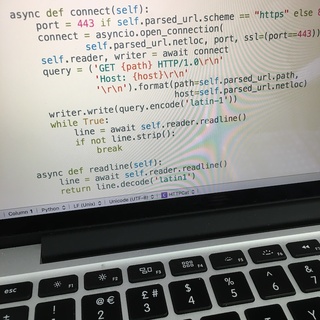☑ That's Good Enough
- All Go: Concurrency Fri Jun 23 2023
- What’s New in Python 3.9 - New Features Thu Oct 27 2022
- What’s New in Python 3.5 - Coroutines Sun Apr 18 2021
- The State of Python Coroutines: Python 3.5 Wed Jul 13 2016
- The State of Python Coroutines: asyncio - Callbacks vs. Coroutines Tue Jul 05 2016
- The State of Python Coroutines: Introducing asyncio Thu Jun 16 2016
- The State of Python Coroutines: yield from Fri Jun 10 2016
June 2023

☑ All Go: Concurrency
In this, my fourth article on the Go programming language, I’m going to tackle the topic of concurrency. This concept of goroutines is one of the languages main selling points, so I’ll be interested to see how they work. We’ll also look at channels, which are used to communicate between goroutines.
This is the 4th of the 6 articles that currently make up the “All Go” series, the first of which was All Go: Basic Semantics.
Read article ( 40 minutes )
October 2022

☑ What’s New in Python 3.9 - New Features
In this series looking at features introduced by every version of Python 3, we move on to Python 3.9 and examine some of the major new features. These include type hinting generics in standard collections, string methods for stripping specified prefixes and suffixes from strings, extensions to function and variable annotations, and new modules for timezone information and topological sorting of graphs.
This is the 19th of the 36 articles that currently make up the “Python 3 Releases” series, the first of which was What’s New in Python 3.0.
Read article ( 26 minutes )
April 2021

☑ What’s New in Python 3.5 - Coroutines
In this series looking at features introduced by every version of Python 3, this is the first looking at Python 3.5. In it we examine one of the major new improvements in this release, new syntax for coroutines.
This is the 8th of the 36 articles that currently make up the “Python 3 Releases” series, the first of which was What’s New in Python 3.0.
Read article ( 24 minutes )
July 2016

☑ The State of Python Coroutines: Python 3.5
I recently spotted that Python 3.5 has added yet more features to make coroutines more straightforward to implement and use. Since I’m well behind the curve I thought I’d bring myself back up to date over a series of blog posts, each going over some functionality added in successive Python versions — this one covers additional syntax that was added in Python 3.5.
This is the 4th of the 4 articles that currently make up the “State of Python Coroutines” series, the first of which was The State of Python Coroutines: yield from.
Read article ( 11 minutes )

☑ The State of Python Coroutines: asyncio - Callbacks vs. Coroutines
I recently spotted that Python 3.5 has added yet more features to make coroutines more straightforward to implement and use. Since I’m well behind the curve I thought I’d bring myself back up to date over a series of blog posts, each going over some functionality added in successive Python versions — this one covers more of the asyncio module that was added in Python 3.4.
This is the 3rd of the 4 articles that currently make up the “State of Python Coroutines” series, the first of which was The State of Python Coroutines: yield from.
Read article ( 16 minutes )
June 2016

☑ The State of Python Coroutines: Introducing asyncio
I recently spotted that Python 3.5 has added yet more features to make coroutines more straightforward to implement and use. Since I’m well behind the curve I thought I’d bring myself back up to date over a series of blog posts, each going over some functionality added in successive Python versions — this one covers parts of the asyncio module that was added in Python 3.4.
This is the 2nd of the 4 articles that currently make up the “State of Python Coroutines” series, the first of which was The State of Python Coroutines: yield from.
Read article ( 7 minutes )

☑ The State of Python Coroutines: yield from
I recently spotted that Python 3.5 has added yet more features to make coroutines more straightforward to implement and use. Since I’m well behind the curve I thought I’d bring myself back up to date over a series of blog posts, each going over some functionality added in successive Python versions — this one covers the facilities up to and including the yield from syntax added in Python 3.3.
This is the 1st of the 4 articles that currently make up the “State of Python Coroutines” series.
Read article ( 9 minutes )
